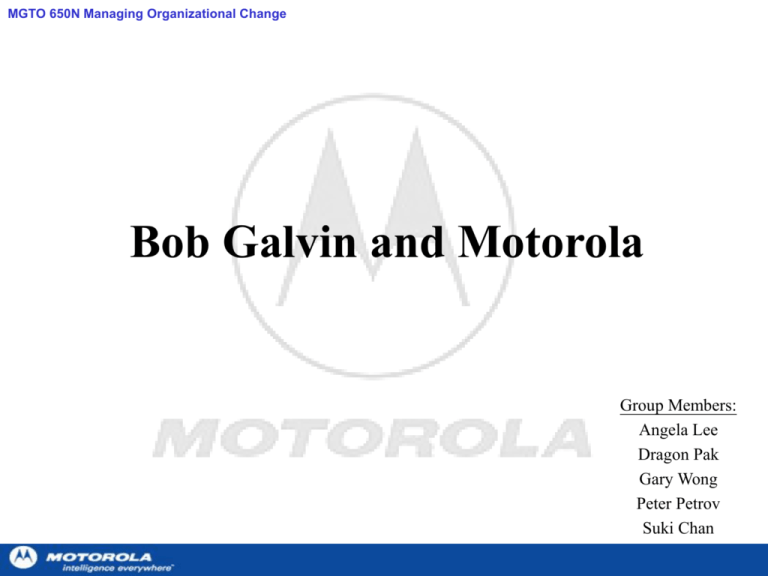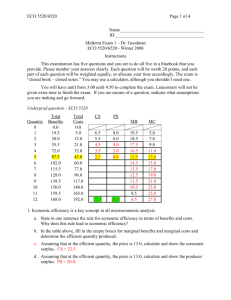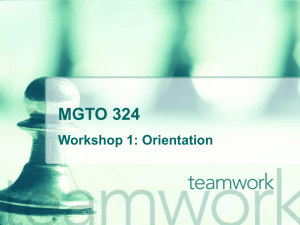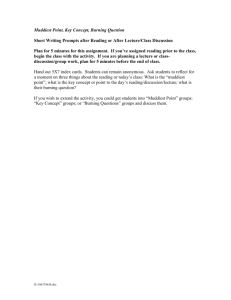Bob Galvin and Motorola, Inc.(A)
advertisement

MGTO 650N Managing Organizational Change Bob Galvin and Motorola Group Members: Angela Lee Dragon Pak Gary Wong Peter Petrov Suki Chan MGTO 650N Managing Organizational Change Our team analysis approach Galvin's missions but no Vision Evaluation of Galvin's delivery Internal response to the speech Can we do it better? When should we Do it? Good Time? Bad Time? MGTO 650N Managing Organizational Change Galvin's missions but no VISION Mission • Simpler Organization structure with direct ties to the customers – Bring management to market/consumer – Smaller, sharp focused business units – Decrease layers of management Where does this lead to ? Nowhere MGTO 650N Managing Organizational Change No Vision but more effective? Galvin is still struggling with the vision of future Motorola More effective running of business change Motorola From Christensen Clayton’s central analysis, more effective running business cycles without clear central strategy always lead to faster and disastrous downfall of large corporate MGTO 650N Managing Organizational Change Hewlett-Packard lesson Carly Fiorina mission failed and fired • Confused central strategy HP = Printer ? PC maker? or Carly Fiorina thought HP= Printer + PC 5 years later, mission failed and kicked out HP share drops $80 $ 20 MGTO 650N Managing Organizational Change Evaluation of Galvin’s Style (Initiating Change) Authoritarian - Thought he could turn the corporation up-sidedown - Thought everyone would follow with no questions Did not structure the change Did not communicate it Got no support MGTO 650N Managing Organizational Change Evaluation of Galvin’s Style (Visionary Leadership) Elements of “Visionary Leadership” • Visions of the future - Technology Roadmap - Promoting investment in R&D • Great inspiration - Initiating the issue of structural reorganization • Initiate action - Fighting “unfair” trade practices MGTO 650N Managing Organizational Change Evaluation of Galvin’s Style (Visionary Leadership) – cont’ Set achievable goals - Participative Management Program Enlist the participation of others - “3 Bears” - Sharing COO positions MGTO 650N Managing Organizational Change Impacts After The Speech May have few supporters Most left the hall with a fear of unknown Feeling being treated unfairly Surprise and confusion more than eagerness MGTO 650N Managing Organizational Change What should be done next? Create a “Burning Platform Clearly state the vision (a road map) Well-communicate the burning platform and the vision (Campaign, workshop..etc.) Put together a critical mass of ‘Change Agent” Top-down approach. Leaders “Walk the Talk” Identification and managment of resistance (structural, political, cultural and technical) Sustain gains on successful changes. MGTO 650N Managing Organizational Change Burning Platform • Significant culture change begins with the creation of a “burning platform”, a compelling vision of why change is needed • An enterprise can not move forward unless the need for change is clearly established MGTO 650N Managing Organizational Change Threat Opportunity Matrix This matrix helps determine the driving factors behind the changes which can then be used in communicating the need. Threats Opportunity (if we don’t change) (if we change) Short Term Short Term Threats: What are the threats if the project does not happen / if we do not do the project? Short Term Opportunities: What are the short term opportunities with the proposed project? Long Term Long Term Threats: What are the threats if the project does not happen / if we do not do the project? Long Term Opportunities: What are the long term opportunities with the proposed project? Focusing on the Long Term ensures involvement beyond what can be gained from the Short Term sense of urgency! MGTO 650N Managing Organizational Change What should be done next? Create a “Burning Platform Clearly state the vision (a road map) Well-communicate the burning platform and the vision (Campaign, workshop..etc.) Put together a critical mass of ‘Change Agent” Top-down approach. Leaders “Walk the Talk” Identification and managment of resistance (structural, political, cultural and technical) Sustain gains on successful changes.. MGTO 650N Managing Organizational Change A Basic Change Model As Is To Be • Change can cause a mixture of thoughts and emotions – – – – Excitement Yearning for the past Unfocused energy Productivity dip—remember, the “dip” is going to happen, however the objective is to lessen the dip, not remove all the pain MGTO 650N Managing Organizational Change What should be done next? Create a “Burning Platform Clearly state the vision (a road map) Well-communicate the burning platform and the vision (Campaign, workshop..etc.) Top-down approach. Leaders “Walk the Talk” and put together a critical mass of ‘Change Agents’ Identifify “Stakeholders” for the change Identification and managment of resistance (structural, political, cultural and technical) Sustain gains on successful changes. MGTO 650N Managing Organizational Change Communication is the Key to Overcoming Resistance Keep stakeholders aware and involved in your project… Gate Reviews Update Meetings Gallery Walks MGTO 650N Managing Organizational Change A war could have been avoided, had Saddam Hussain known better about ‘Arms Inspection....’ MGTO 650N Managing Organizational Change MGTO 650N Managing Organizational Change What should be done next? Create a “Burning Platform Clearly state the vision (a road map) Well-communicate the burning platform and the vision (Campaign, workshop..etc.) Top-down approach. Leaders “Walk the Talk” and put together a critical mass of ‘Change Agents’ Identifify and leverage on “Stakeholders” to maximize change efforts Identification and managment of resistance (structural, political, cultural and technical) Sustain gains on successful changes MGTO 650N Managing Organizational Change Leaders’ Committment Highly visible Involve senior management Serve as role models - ‘Walk the Talk’ Be consistent with message with the organization’s visions, goals and expectations Listen and address concerns Allocate resources and remove barriers MGTO 650N Managing Organizational Change What should be done next? Create a “Burning Platform Clearly state the vision (a road map) Well-communicate the burning platform and the vision (Campaign, workshop..etc.) Top-down approach. Leaders “Walk the Talk” and put together a critical mass of ‘Change Agents’ Identifify and leverage on “Stakeholders” to maximize change efforts Identification and managment of resistance (structural, political, cultural and technical) Sustain gains on successful changes. MGTO 650N Managing Organizational Change What is Stakeholder Management? Identify Stakeholders Understand Stakeholders Influence Stakeholders MGTO 650N Managing Organizational Change Stakeholder Management Leadership Team: Middle Management: Frontline Employees: First link in the action leadership Second link in the action leadership Third link in the action leadership chain chain chain Successful Change Needs an Unbroken Leadership Chain, Top to Bottom MGTO 650N Managing Organizational Change What should be done next? Create a “Burning Platform Clearly state the vision (a road map) Well-communicate the burning platform and the vision (Campaign, workshop..etc.) Top-down approach. Leaders “Walk the Talk” and put together a critical mass of ‘Change Agents’ Identifify and leverage on “Stakeholders” to maximize change efforts Identification and managment of resistance (structural, political, cultural and technical) Sustain gains on successful changes. MGTO 650N Managing Organizational Change Major Types of Resistance • Technical Resistance: believe changes reveal inadequacy or stupidity on business and process knowledge • Political Resistance: see change (or any restructuring as a re-shuffle (and possibly loss of power and control ) • Structural Resistance: Organization structure is not conducive to change (e.g. rigidly structured hierarchy that does not encourage collaboration and/or communication) • Cultural Resistance: Deeply entrenched beliefs, assumptions, patterns of behaviours. It is human nature to attach to the ‘Status Quo’. MGTO 650N Managing Organizational Change What should be done next? Create a “Burning Platform Clearly state the vision (a road map) Well-communicate the burning platform and the vision (Campaign, workshop..etc.) Top-down approach. Leaders “Walk the Talk” and put together a critical mass of ‘Change Agents’ Identifify and leverage on “Stakeholders” to maximize change efforts Identification and managment of resistance (structural, political, cultural and technical) Sustain gains on successful changes MGTO 650N Managing Organizational Change Sustaining Gains Communication Spread success stories Replication of best practices Rewards (monetary and/or psychological) system Continuous improvement Control plan MGTO 650N Managing Organizational Change Initiating change in a good time (Advantages) Enough financing Financial strong for correction Basis for a future growth Philosophy of life – “change and grow or stagnate” MGTO 650N Managing Organizational Change Initiating change in a good time (Difficulties) Resistance of employees Misunderstanding of Board of Directors and shareholders MGTO 650N Managing Organizational Change Q uestions? - Thank you!







